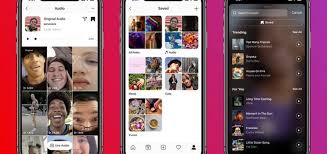It’s impossible to know yet whether Instagram’s TikTok clone ‘Reels’ will end up becoming a key element of the app experience. But Instagram’s certainly not leaving anything to chance – today, Instagram has launched yet another set of updates for Reels, in order to further align the tool with TikTok usage trends.
The latest Reels updates are all about audio, and helping users engage in music-related trends in the app.
The new options being added to Reels this week are:
- Save Audio – This will give users the capacity to save sounds in-app, which they can then use in their own Reels clips
- Share Audio Pages – Users will now be able to share collections of Reels which use a specific piece of audio via DM
- Audio Browser – Users will be able to search for sounds and music, and the Reels clips that use them
As noted, these new additions align with the rising use of audio in remixes and the like across TikTok. Much like Vine before it, music has become a central focus for TikTok clips, with many – if not most – clips using popular songs, and facilitating themed content based on the track.
There’s also been a rising trend of users referencing other user audio, or voice clips, like Sarah Cooper’s re-creations of quotes from US President Donald Trump.
The Save Audio option will better facilitate the expansion of this, while the share audio pages option will help users further distribute popular content trends. That’ll likely see even wider reach for such via the recently announced integration of Instagram Direct and Messenger, which will mean that users will be able to share these trends direct with their connections in both apps.
The velocity of Reels updates shows that Instagram’s looking to evolve the product quickly, in order to catch up to TikTok – but with TikTok now looking like it will remain, unchanged, in the US, Reels’ opportunity for significant, rapid expansion looks to be lost, at least for the time being.
Instagram would have been hoping that the proposed White House ban on TikTok would have been upheld, at least for a period, which would enable Reels to fill the gap, and gather up users, which it could then seek to hold onto with improved monetization tools and reach potential.
Indeed, Instagram is already working on Reels monetization – it announced a coming Reels shopping integration earlier this week, which also looks set to enable users to tag products in their clips.
That could be a big boost for Reels usage, and as noted, that would have been even more ideal had TikTok been removed from the US market, because where Reels has gained traction, reportedly, is in India, where TikTok is banned.
Instagram hasn’t released any official usage data for Reels as yet, but it wouldn’t be surprising to see Reels already seeing solid usage. Whether that usage slows TikTok is another question – thus far, it doesn’t appear to have had any impact, with TikTok still leading the app download charts, once again, in September.
Downloads, of course, don’t necessarily correlate with app usage, and many more people have already downloaded Instagram, so this is not a definitive measure of ongoing success. But it does show that TikTok’s popularity is holding, despite the new challenger.
The real test for TikTok will come down to monetization. At some stage, once its creators are big enough, they’ll expect to get paid for their efforts, and the audience they bring to the app. Right now, video stars can make more money on YouTube and Instagram, because TikTok’s monetization funnels are not as evolved as yet.
That could change, especially if Walmart is able to fast-track in-stream shopping options within TikTok clips as part of the proposed takeover deal. But as noted, Instagram is also looking to move quickly on this.
A reminder: Vine was shut down after its top creators pushed for more revenue-share, and parent company Twitter was unable to accommodate their requests. If TikTok stars can’t make money, or as much money as they could on other apps, that could still, eventually, spell trouble for the app.

I don’t think the title of your article matches the content lol. Just kidding, mainly because I had some doubts after reading the article. https://www.binance.com/en-IN/register?ref=UM6SMJM3
Your article helped me a lot, is there any more related content? Thanks!
Your point of view caught my eye and was very interesting. Thanks. I have a question for you.